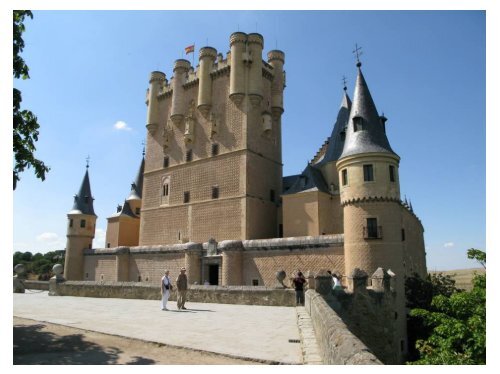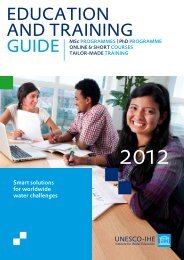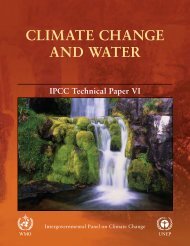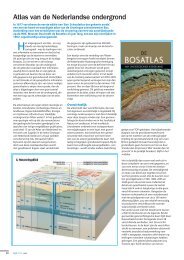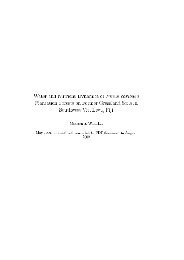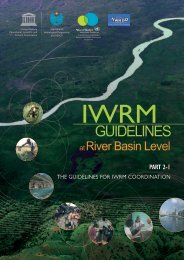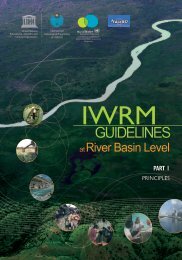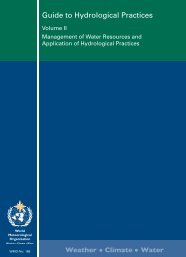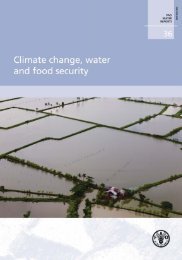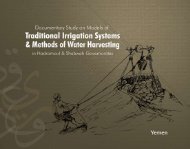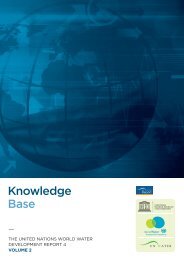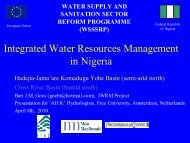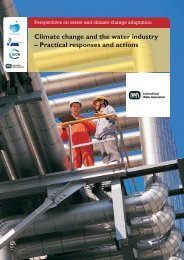Presentation Amsterdam Water Supply Dunes - Hydrology.nl
Presentation Amsterdam Water Supply Dunes - Hydrology.nl
Presentation Amsterdam Water Supply Dunes - Hydrology.nl
You also want an ePaper? Increase the reach of your titles
YUMPU automatically turns print PDFs into web optimized ePapers that Google loves.
Introduction for the group of the<br />
Helsinki University of Technology<br />
in the<br />
<strong>Amsterdam</strong> <strong>Water</strong> <strong>Supply</strong> <strong>Dunes</strong><br />
Frank Smits<br />
Leiduin, March 29 th , 2010<br />
<strong>Amsterdam</strong>, 10 april 2010
• introduction<br />
• <strong>Water</strong>net <br />
• World <strong>Water</strong>net<br />
• history of the water supply of <strong>Amsterdam</strong><br />
• the <strong>Amsterdam</strong> <strong>Water</strong> <strong>Supply</strong> <strong>Dunes</strong><br />
• purification of the drinking water<br />
• safari by bike in the <strong>Water</strong> <strong>Supply</strong> <strong>Dunes</strong>
Service for<br />
<strong>Water</strong>management & Sewerage<br />
<strong>Water</strong>board Amstel, Gooi & Vecht<br />
<strong>Amsterdam</strong> <strong>Water</strong> <strong>Supply</strong>
<strong>Water</strong>net is the first and o<strong>nl</strong>y<br />
governmental<br />
organisation in the Netherlands that manages the<br />
complete watercycle :<br />
• surface water,<br />
• groundwater,<br />
• drinking water,<br />
• sewerage and<br />
• treatment of sewerage water.
surfacewater &<br />
sewerage treatment<br />
sewerage<br />
drinking water
surfacewater &<br />
sewerage treatment<br />
sewerage<br />
drinking water<br />
700 km 2<br />
managed area<br />
1700 km dike
Tienhovense Plassen
Ankeveense Plassen
Laarder Wasmeren
Gein
Loosdrechtse Plassen
surfacewater &<br />
sewerage treatment<br />
sewerage<br />
drinking water<br />
4000 km of<br />
sewer pipe<br />
treatment of<br />
130 million m 3<br />
sewerage water<br />
per year
sewage treatment plants<br />
"´<br />
Westpoort %[<br />
w a t e r h u i s h o u d k u n d i g e<br />
i n r i c h t i n g<br />
zuiveringswerken en gerioleerde<br />
gebieden<br />
kaart 2c<br />
"´<br />
Oost<br />
%[<br />
£<br />
Zuid "´<br />
%[<br />
Amstelveen %[<br />
"´<br />
Weesp<br />
"´ %[<br />
"´ Huizen<br />
%[<br />
Hor ster meer<br />
%[<br />
%[<br />
"´<br />
Blaricum<br />
renewed<br />
Uithoorn<br />
"´<br />
%[<br />
"´<br />
De Ronde Venen<br />
%[<br />
"´<br />
"´<br />
"´ %[<br />
Loenen<br />
%[<br />
Hilv ers um<br />
in design<br />
%[<br />
Nieuwveen (Rij<strong>nl</strong>and)<br />
planned<br />
%[ "´<br />
Breukelen (H DSR)<br />
Maarssen<br />
"´ %[<br />
existing<br />
%[<br />
De Bilt (H DSR)<br />
"´ %[<br />
Utr echt (H DSR)
1.000.000 i.e.<br />
max. 30.000 m 3 /h<br />
small footprint<br />
8 m deep AT’s<br />
central sludge treatment<br />
coupling with incineration plant
12 drinking water companies<br />
1200 * Mm³ per year<br />
2/3 ground water<br />
1/3 surface water from<br />
the river Rhine and Meuse
transport system<br />
and the drinking water<br />
distribution area<br />
raw water<br />
pre-treated water<br />
drinking water<br />
pumping station<br />
production and distribution<br />
part of the production
transport system<br />
and the drinking water<br />
distribution area<br />
2700 km of pipes<br />
95 million m 3 per year<br />
for<br />
0,8 million people<br />
1,35 euro / m 3<br />
raw water<br />
pre-treated water<br />
drinking water<br />
pumping station<br />
production and distribution<br />
part of the production
aquifer thermal energy storage
aquifer thermal energy storage
aquifer thermal energy storage
aquifer thermal energy storage<br />
CO2-emission of <strong>Amsterdam</strong> [kiloton]<br />
other measures<br />
sustainable energy (850)<br />
garbage incineration(320)
aquifer thermal energy storage<br />
current use of sustainable energy versys potential use in 2025<br />
[prevented kiloton CO2]
aquifer thermal energy storage
A<br />
C<br />
B
saving of energy in three situations<br />
new construction C&A up to 50 %<br />
renovation Beurs 30 to 40 %<br />
existing installation Bijenkorf up to 30 %
2<br />
1<br />
6<br />
5<br />
3<br />
7<br />
4<br />
8<br />
9<br />
11<br />
12<br />
10
• introduction<br />
• <strong>Water</strong>net <br />
• World <strong>Water</strong>net<br />
• history of the water supply of <strong>Amsterdam</strong><br />
• the <strong>Amsterdam</strong> <strong>Water</strong> <strong>Supply</strong> <strong>Dunes</strong><br />
• purification of the drinking water<br />
• safari by bike in the <strong>Water</strong> <strong>Supply</strong> <strong>Dunes</strong>
distribution of the salt<br />
high discharge<br />
low discharge
<strong>Water</strong>net, started in 2006, is a relatively young<br />
organisation, but its roots date back to 1307 when<br />
the oldest predecessor of the <strong>Water</strong>board officially<br />
was founded, and to 1851 when the <strong>Amsterdam</strong><br />
<strong>Water</strong> <strong>Supply</strong> started.
• introduction<br />
• <strong>Water</strong>net <br />
• World <strong>Water</strong>net<br />
• history of the water supply of <strong>Amsterdam</strong><br />
• the <strong>Amsterdam</strong> <strong>Water</strong> <strong>Supply</strong> <strong>Dunes</strong><br />
• purification of the drinking water<br />
• safari by bike in the <strong>Water</strong> <strong>Supply</strong> <strong>Dunes</strong>
• introduction<br />
• <strong>Water</strong>net <br />
• World <strong>Water</strong>net<br />
• history of the water supply of <strong>Amsterdam</strong><br />
• the <strong>Amsterdam</strong> <strong>Water</strong> <strong>Supply</strong> <strong>Dunes</strong><br />
• purification of the drinking water<br />
• safari by bike in the <strong>Water</strong> <strong>Supply</strong> <strong>Dunes</strong>
country estate Leyduin, Jacob van Lennep
drinking water from the dunes<br />
• 1853 shallow dune water extraction<br />
• 1903 deep extraction with wells<br />
• 1957 artificial infiltration in the dunes with pretreated<br />
water from the Lek Canal and further extraction
canal extraction 1853-1903<br />
Precipitation - evapotranspiration<br />
20 m<br />
msl<br />
North Sea<br />
Polder<br />
-20<br />
-40<br />
-60<br />
-80<br />
-100<br />
-120<br />
-140<br />
1 km<br />
c = 1 year<br />
c = 4 years<br />
c = 40 years<br />
c = 200 years
million m 3 / year<br />
80<br />
70<br />
60<br />
50<br />
40<br />
30<br />
20<br />
10<br />
0<br />
1850<br />
1860<br />
shallow aquifer<br />
deep aquifer<br />
infiltrated river water<br />
1870<br />
1880<br />
1890<br />
1900<br />
1910<br />
1920<br />
1930<br />
1940<br />
1950<br />
1960<br />
1970<br />
1980<br />
1990<br />
2000
canal extraction 1903<br />
Precipitation - evapotranspiration<br />
20 m<br />
msl<br />
North Sea<br />
Polder<br />
-20<br />
-40<br />
-60<br />
-80<br />
-100<br />
-120<br />
-140<br />
1 km<br />
c = 1 year<br />
c = 4 years<br />
c = 40 years<br />
c = 200 years
million m 3 / year<br />
80<br />
70<br />
60<br />
50<br />
40<br />
30<br />
20<br />
10<br />
0<br />
1850<br />
1860<br />
shallow aquifer<br />
deep aquifer<br />
infiltrated river water<br />
1870<br />
1880<br />
1890<br />
1900<br />
1910<br />
1920<br />
1930<br />
1940<br />
1950<br />
1960<br />
1970<br />
1980<br />
1990<br />
2000
deep extraction with wells 1903<br />
20 m<br />
msl<br />
North Sea<br />
Polder<br />
-20<br />
-40<br />
1906<br />
1915 1921<br />
1903<br />
-60<br />
-80<br />
-100<br />
-120<br />
-140<br />
1 km<br />
c = 1 year<br />
c = 4 years<br />
c = 40 years<br />
c = 200 years
deep extraction with wells 1939<br />
20 m<br />
msl<br />
North Sea<br />
Polder<br />
-20<br />
-40<br />
1906<br />
1915 1921<br />
1903<br />
-60<br />
-80<br />
-100<br />
-120<br />
-140<br />
1 km<br />
c = 1 year<br />
c = 4 years<br />
c = 40 years<br />
c = 200 years
deep extraction with wells 1956<br />
20 m<br />
msl<br />
North Sea<br />
Polder<br />
-20<br />
-40<br />
1906<br />
1915 1921<br />
1903<br />
-60<br />
-80<br />
-100<br />
-120<br />
-140<br />
1 km<br />
c = 1 year<br />
c = 4 years<br />
c = 40 years<br />
c = 200 years
million m 3 / year<br />
80<br />
70<br />
60<br />
50<br />
40<br />
30<br />
20<br />
10<br />
0<br />
1850<br />
1860<br />
shallow aquifer<br />
deep aquifer<br />
infiltrated river water<br />
1870<br />
1880<br />
1890<br />
1900<br />
1910<br />
1920<br />
1930<br />
1940<br />
1950<br />
1960<br />
1970<br />
1980<br />
1990<br />
2000
transport system<br />
and the drinking water<br />
distribution area<br />
raw water<br />
pre-treated water<br />
drinking water<br />
pumping station<br />
production and distribution<br />
part of the production
coagulation - sedimentation - rapid sand filtration<br />
• flocculant: ironchloride<br />
• removal of: sludge, phosphate, organics,<br />
bacteria, heavy metals
infiltration of river water in the AWD
abstraction canal<br />
infiltration ponds<br />
influent canal<br />
storage canal
ecovery without wells 1981<br />
20 m<br />
msl<br />
North Sea<br />
Polder<br />
-20<br />
-40<br />
1906<br />
1915 1921<br />
1903<br />
-60<br />
-80<br />
-100<br />
-120<br />
-140<br />
1 km<br />
c = 1 year<br />
c = 4 years<br />
c = 40 years<br />
c = 200 years
why infiltration in the dunes <br />
• natural filter for bacteria and viruses<br />
• natural filter for organic contaminants<br />
• smoothing of water quality and temperature<br />
• storage buffer to overcome intake stops
different roles in the dunes<br />
• drinking water production<br />
• management of nature<br />
• recreation<br />
these are partly conflicting interest !
deep infiltration system<br />
• 4 infiltration wells<br />
filters located<br />
20-50 m deep<br />
• total injection capacity<br />
0.7 million m³/year<br />
• part of the old deep<br />
extraction system as<br />
recovery wells
infiltration well<br />
supply canal<br />
1<br />
3<br />
2<br />
4 5<br />
6<br />
- 30 meter<br />
6.4 million m 3 injected<br />
- 60 meter
• introduction<br />
• <strong>Water</strong>net <br />
• World <strong>Water</strong>net<br />
• history of the water supply of <strong>Amsterdam</strong><br />
• the <strong>Amsterdam</strong> <strong>Water</strong> <strong>Supply</strong> <strong>Dunes</strong><br />
• purification of the drinking water<br />
• safari by bike in the <strong>Water</strong> <strong>Supply</strong> <strong>Dunes</strong>
treatment philosophy<br />
• multiple barriers<br />
– pathogens<br />
– organic micropollutants<br />
• central softening<br />
• biologically stable<br />
• no chlorine
coagulation<br />
sedimentation<br />
rapid sand filter<br />
artificial infiltration<br />
aeration<br />
rapid sand filter<br />
ozonation<br />
pellet softening<br />
activated carbon filter<br />
slow sand filter<br />
DRINKING WATER
water treatment<br />
physical en chemical water quality:<br />
• removal of suspended solids<br />
• removal of heavy metals<br />
• removal of iron and manganese<br />
• hardness reduction<br />
• reduction of colour, taste and odour<br />
• barrier against micro-pollutants like pesticides
water treatment<br />
biological water quality:<br />
• disinfection<br />
• nutrient removal<br />
• no chlorine<br />
• o<strong>nl</strong>y in combination with a<br />
high quality distribution system
• introduction<br />
• <strong>Water</strong>net <br />
• World <strong>Water</strong>net<br />
• history of the water supply of <strong>Amsterdam</strong><br />
• the <strong>Amsterdam</strong> <strong>Water</strong> <strong>Supply</strong> <strong>Dunes</strong><br />
• purification of the drinking water<br />
• safari by bike in the <strong>Water</strong> <strong>Supply</strong> <strong>Dunes</strong>
Frank Smits<br />
<strong>Water</strong>net, Onderzoek & Advies<br />
Vogelenzangseweg 21<br />
2114 BA Vogelenzang<br />
Korte Ouderkerkerdijk 7<br />
1096 AC <strong>Amsterdam</strong><br />
020 608 75 46 06 532 714 39<br />
frank.smits@waternet.<strong>nl</strong>


